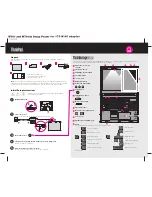
20
value should not be changed. Higher resolutions may improve flattener quality, but will
result in larger file sizes.
•
Gradient and Mesh Resolution:
For objects that use these effects, including drop
shadows and feathering, a setting of 300 dpi is sufficient in most cases.
•
Convert All Text to Outlines:
This option converts all text in the document to outlines
which may slightly fatten the type, but makes the width consistent. Use this setting to
avoid type getting partially converted to outlines, which could result in different type
thicknesses.
•
Convert All Strokes to Outlines:
To ensure that the width of all strokes in the artwork
stays consistent, select this option, which converts all strokes in the document to filled
outlines. This will usually slightly thicken the appearance of strokes.
•
Clip Complex Regions:
This option is only available when the Raster/Vector slider is set
to less than 100. This setting decreases the probability of getting color stitching in the
output. Stitching is the artifacts that potentially appear between atomic regions. (When
overlapping transparent objects are flattened, each discrete shape that results from the
overlapping objects is called an atomic region.) When complex areas get rasterized during
the flattening process, it normally happens in a “blocky” fashion that can cut through
objects, such that part of an object can be rasterized while the rest remains in vector
form. Stitching results from software trying to anti-alias the edge of atomic regions. It
can cause white or black lines to appear on screen, although they don’t typically appear in
high-resolution print output. Selecting Clip Complex Regions decreases the probability
of stitching by ensuring that the raster/vector boundaries always fall along existing
natural object paths.
F l at te ne r P re v ie w pa le t te
Whenever creating color separations with a file containing transparency, you should care-
fully examine which objects will be affected by overprinting and flattening before printing.
To make this process easy and efficient, Illustrator CS provides previewing capabilities that
allow you to zoom in and see which objects will be affected by flattening and overprinting
(among other things) given the current flattener settings. Potential problems can be found
and corrected before they become costly.















































